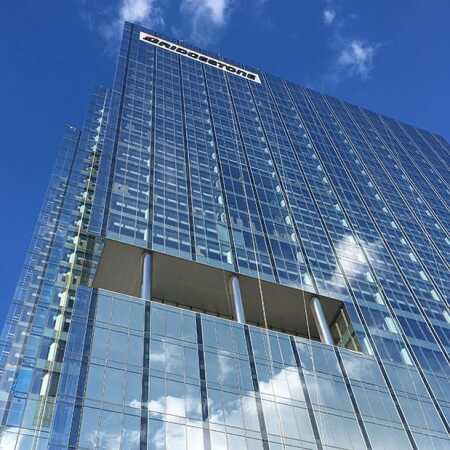
Bridgestone Americas, the largest subsidiary of Bridgestone Corporation, the giant tire and rubber company, opened its 30-story, 514,000-square-foot (48,000 sq m) building in downtown Nashville in December 2017. Bridgestone Tower is the second facility opened last year by the company in the Nashville metropolitan area. In June, the Bridgestone Operations Center opened in Antioch, Tennessee, with more than 450 employees and contractors. (Integra Realty Resources-Nashville)
This article appeared in the summer issue of Urban Land on page 87.
From her 25th-floor office in downtown Austin, Texas, Carey Gunn Venditti, a partner in the real estate practice group at international law firm DLA Piper, stops talking about the vitality of the city’s economy and glances out the window at the construction cranes dotting the skyline.
“Today, I count eight cranes working on both office and residential high-rise projects,” she says. “That’s proof that Austin real estate remains strong. Unless there is an unforeseen event affecting the national or global economy, we expect this trend to continue.”
Austin is but one of the cities in states in the U.S. South—Texas, Louisiana, Alabama, Florida, Georgia, the Carolinas, and Tennessee—that are experiencing expanding economies and increasing development. Technology, tourism, education, medical, and manufacturing are among the industries driving the real estate sector in the region.
Technology has become integral to the South’s economic well-being and is becoming a factor in real estate development in areas that had not been known for high tech. Tampa Bay anchors the tech corridor in central Florida and is gaining a global reputation as a hub for innovative research and development in life sciences, manufacturing, and defense and security, says Bradford L. Johnson, senior managing director at the Tampa Bay office of New York City–based Integra Realty Resources (IRR), which provides real estate valuation, counseling, and advisory services.
“Tampa’s MacDill Air Force Base hosts U.S. Central Command and U.S. Special Operations Command as well as 38 additional mission partners,” Johnson says. “A $14 billion military industry has developed in Tampa with specialized security, cyber security, intelligence, information technology, simulation training, and advanced manufacturing firms, making Tampa a top market for defense contractors.”
In New Orleans, tourism continues to be strong, but the city has also witnessed significant movement in the technology field and anticipates new energy around the medical and research sectors, particularly with the opening of two new medical centers downtown—University Medical Center and the Veterans Affairs Regional Medical Center, says Leigh M. Ferguson, director of economic development at the Downtown Development District of New Orleans. “Our technology sector is growing with recent announcements such as that of Virginia-based DXC Technology, which describes itself as an ‘end-to-end IT services company,’ opening a New Orleans office this year that will eventually employ 2,000 people.”
Manufacturing also has become a linchpin in the region, particularly in Alabama, where, along with aviation and technology, it is fueling the state economy and the real estate sector. “Alabama is very diverse in the products and services it offers,” says Catherine Sloss Jones of Birmingham’s Sloss Real Estate Company. “Investments from outside firms like Hyundai in Montgomery, Mercedes in Tuscaloosa, and recently Toyota and Mazda in Huntsville indicate a climate ripe for job growth in the auto manufacturing sector,” she continues. “Huntsville has the largest concentration per capita of PhDs in America because of NASA, and Birmingham has a vibrant and growing tech scene that is just beginning to impact our city.”
While America’s South continues on a steady course with a growing population and an increasing number of jobs, officials are acting on some challenges, which include traffic, housing affordability, education needs, and the rising cost of labor and materials. Georgia and Atlanta are spending billions to improve infrastructure and drive the real estate market, notes Robert P. Voyles, principal at Atlanta-based real estate firm Seven Oaks Company.
“There is a lot of infrastructure development in and around the city now,” says Voyles. “The state of Georgia is investing some $10 billion in major interstate improvements as well as funding a managed-lane system that will cover the lion’s share of Atlanta’s busiest highways. We are definitely working to improve mobility to attract new business.”
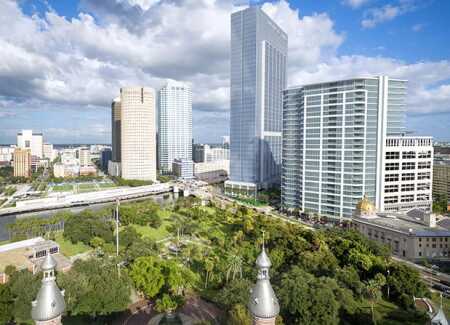
Hillsborough River Realty Company is planning Lafayette Place, a 1.7 million-square-foot (158,000 sq m) development that will dramatically change Tampa’s skyline. Current plans for the project include the 40-story Lafayette Tower in addition to residential, hotel, and retail uses. The start of construction has not been scheduled. (BDG Architects)
Florida
New business and new jobs are essential to real estate expansion. In Florida, economic growth and robust development are being reported from coast to coast. Orlando is seeing a robust real estate market in suburban locations with strong access to job centers including Lake Mary, Lake Nona/Medical City, and Horizon West.
“We also anticipate seeing an increase in the amount of interest from builders and buyers in edge locations to accommodate growing price constraints for both land and home values,” says M. Rebecca Wilson, shareholder and chair of the land use, zoning, and environmental group at Drosdick, Doster, Kantor & Reed, an Orlando-based law firm. “There is still a significant amount of infill demand from consumers, and developers are having a challenging time finding land to accommodate it.”
While Orlando—home to the Walt Disney World Resort, the Universal Orlando Resort, and others—historically has benefited from the hospitality industry, the region is now experiencing a more balanced distribution of job growth. “The development of the University of Central Florida downtown campus and expansion of the airport reinforce the opportunity for Orlando to continue diversifying its job core and creating a solid economic foundation,” Wilson says.
Already, a new employment center, NeoCity, is emerging in Osceola County, south of Orlando. Lisa Dilts, principal at Compspring in Orlando, an independent real estate advisory firm, says, “The employers being attracted to NeoCity are focused on the research of micro and nano electronics, semiconductors, and photonics. Job projections for this employment center are in the thousands over the next five to ten years and are ultimately projected to rival the employment numbers of Disney.”
Clouding the area’s sunny skies, however, are the availability of labor and the rising cost of materials. Along with much-needed construction projects throughout central Florida, the $2.3 billion I-4 Ultimate, a 21-mile (34 km) makeover, is absorbing much of the area’s labor and building supplies such as steel and is pushing up the cost of materials. “Many local governments also are contemplating or have adopted large increases to impact fees,” says Wilson. “This is another cost added to new construction not borne by existing development.”
To the west, continued job growth is also encouraging development in Tampa. “We’re seeing stability in all real estate sectors thanks to new employment in industries such as technology,” says Barry Karpay, chair of ULI Tampa Bay. “Biotechnology giant Amgen has opened a facility in Tampa with promises to create as many as 450 jobs here by 2018. We’re riding a nice, steady wave. Not one real estate sector is reporting a slowdown.”
One of the major projects in the city is Water Street Tampa, a $3 billion mixed-use development of Strategic Property Partners, the real estate firm backed by NHL Tampa Bay Lightning owner Jeff Vinik and Bill Gates’s Cascade Investment. Water Street Tampa is expected to include 2 million square feet (186,000 sq m) of office space, 3,500 rental and for-sale residential units, 1 million square feet (93,000 sq m) of retail, and two hotels totaling 650 rooms, Karpay says.
Other large-scale developments either in the planning stages or under construction in Tampa include Lafayette Place, a proposed three-parcel, mixed-use development on the west side of the Hillsborough River with residential, hotel, office, and retail space totaling some 1.7 million square feet (158,000 sq m), and Riverwalk Tower, a high-end project that should break ground this year, says IRR’s Johnson.
“Riverwalk Tower is a 1.47-acre [0.6 ha] site with over 350 linear feet [107 m] along the Tampa Riverwalk,” he continues. “It will be developed with a 52-story luxury office and residential building, which will include ground-level retail, two waterfront restaurants, and a seven-story parking garage. The 14-story office component will contain 215,000 square feet [20,000 sq m] and the residential component will include 210 luxury condominiums. More than 4,100 residential units in 13 buildings are under construction or in the planning stages within a mile [1.6 km] of the urban core.”
A surge in residential development is also occurring in downtown St. Petersburg. “Nearly half a billion dollars of construction is either underway or expected to start later this year,” Johnson says. “The top five residential projects will add more than 1,500 rental units to the 1,340 units finished in the last three years. One noteworthy project is One St. Petersburg, a luxury condominium tower under construction and expected to be completed later this year, with an average price per unit of $1 million.”
In southern Florida, international tourism is forecast to be stronger this year as the dollar weakens and the Miami Beach Convention Center reopens following a $620 million renovation and expansion. “South Florida’s economy is diversifying,” says Anthony M. Graziano, senior managing director at the Miami office of IRR. “The core banking, finance, and real estate sectors for the Southeast are based in south Florida. The region’s medical universities and infrastructure and emerging technology employment base are also expected to expand.”
A major factor in the area’s economy is construction, Graziano says, and the service sectors that support it. “A lot of this construction activity is expected to turn toward affordable housing and mixed use in 2018–2020,” he continues. “Infrastructure spending favors south Florida’s major contractors and engineers, so a federal push in infrastructure funding will propel this sector through a dip in commercial and residential construction activity.”
Georgia
As in Florida, Atlanta’s real estate markets also are firing on all cylinders, says Voyles of Seven Oaks. “We have not overbuilt in any of our markets but are seeing slow and steady increased construction,” he continues. “The city is on a steady ascent across a number of different product types, and has been for several years. The multifamily sector is extremely active. We continue to see steady absorption across all the different markets.”
Some of the most exciting development in the city is happening in the Atlanta region’s older existing regional town centers around historic community downtowns, both on and off mass transit lines, Voyles says. “We are seeing some very interesting projects coming about in those markets,” he adds. “Equally exciting are the infrastructure improvements the city and state are making to increase mobility.”
South Carolina
Thanks to positive job and population expansion, South Carolina’s major cities—and many of its tertiary markets including Hilton Head/Bluffton and Myrtle Beach—are reporting solid development, says Robert L. Morgan, chair of ULI South Carolina.
“Charleston and Greenville continue to lead the pack with very dynamic growth, with the Port of Charleston and Boeing being the primary drivers,” says Morgan. “Mercedes-Benz and Volvo have made large investments in Charleston over the past 24 months. All this has led to rent growth and strong absorption in all market sectors, with speculative building occurring in office and industrial. Multifamily is delivering several thousand new units across the metro area.”
Charleston remains a top tourist destination, and the port set a record in annual cargo shipments last year, notes Fitzhugh L. Stout, IRR senior managing director. “The harbor is being dredged to accommodate the new Panamax vessels that hold up to 13,000 containers compared to the former capacity of 5,000 containers,” Stout says. “The port was a primary driver for Boeing, Volvo, and Mercedes in selecting Charleston as a location for their existing and current manufacturing facilities under construction. We expect continued growth this year in all real estate sectors.”
In Greenville, BMW, Michelin, Fuji, and others have created a critical manufacturing hub centered between Atlanta and Charlotte. “Because Greenville is consistently ranked on lists noting its quality of life and business-friendly environment, we are seeing most real estate sectors running at a feverish pace to keep up with demand,” Morgan says. “Downtown Greenville’s building boom continues with office, multifamily rental, hospitality, and for-sale housing. Most of the new projects are mixed-use with a retail component.”
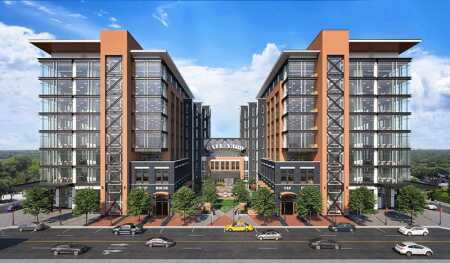
Beacon Partners, one of the largest privately held owners of office and industrial buildings in the Carolinas, has broken ground on the RailYard Southend, a 350,000-square-foot (33,000 sq m) mixed-use office project in South End Charlotte. The development, expected to be completed in the first quarter of next year, will contain two 160,000-square-foot (14,900 sq m) office buildings, with 30,000 square feet (2,800 sq m) of shops and restaurants. (Beacon Partners)
North Carolina
With over 36,000 jobs added in the last year and an unemployment rate of 4.2 percent, significant job growth has been one of the major economic drivers in Charlotte, North Carolina’s largest city, says Stout. “Demand for apartments in the Charlotte market continues to be strong, with 6,289 units absorbed over the past 12 months,” he adds. “Despite the large number of units under construction [11,674 units] and planned [12,645 units], the overall average vacancy is 5.8 percent. Demand is expected to remain strong this year, with vacancy remaining in the 6 to 7 percent range. Rent growth will slow but should increase [to] between 2.5 and 3.0 percent.”
Charlotte’s economy has historically been dominated by finance, but it has diversified since the 2008 economic downturn. “Bank of America and Wells Fargo are the major players, but many other national and regional banks have expanded their presence in Charlotte in the last seven or eight years,” says Rob Cochran, managing director in the Charlotte office of Cushman & Wakefield. “Fintech—technology used to support banking and financial services—is growing as well. Last year, insurance firm Allstate announced plans to relocate nearly 2,500 jobs to Charlotte over the next several years, many from its fintech group. While Charlotte isn’t as tech-focused as the Raleigh-Durham region, we have had significant job growth in that sector in the past few years.”
Among the major developments is Beacon Partners’ Rail Yard, a 350,000-square-foot (33,000 sq m) mixed-use office project south of the central business district (CBD) in Charlotte’s South End. Across from a light-rail stop, the development will feature street-level retail and residential micro-units in addition to two office buildings.
Given Charlotte’s growth, keeping up with infrastructure needs is one of the region’s biggest challenges. “Roads, water and sewer extensions, and continued growth of mass transit are top of mind for city officials,” says Cochran.
Technology-focused Raleigh and Durham continue to prosper, particularly in both downtowns and midtown Raleigh.
“The urban cores are very active, with more office, residential, hotel, and street retail coming,” says John M. Kane, founder and chief executive officer of Raleigh-based Kane Realty. “The universities feed all of the Research Triangle Park [RTP] area. The reputation of the RTP—one of the largest research parks in the world—our outstanding airport with 54 direct flights, along with the stability of Raleigh as the state capital, combined with extraordinary Duke and UNC [University of North Carolina] health systems, position us for future growth and success.”
But, looking ahead, Kane says the region must reposition itself. “We need to move forward with appropriate transit options,” he says. “We also need to address the need for workforce housing.”
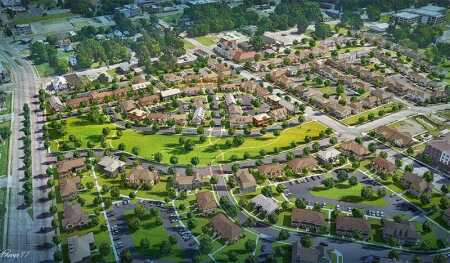
Construction is underway on South City, a $210 million mixed-use redevelopment project in Memphis. The primary development area is the former site of Foote Homes, the city’s last traditional public housing complex. The housing component consists of six phases of about 110 to 120 units per phase constructed through 2022. Of the 712 total units, 393 will be for former public housing residents or for U.S. Department of Housing and Urban Development (HUD)–assisted individuals and families. (Looney Ricks Kiss)
Tennessee
Tourism and the educational and medical sectors continue to push real estate activity in Memphis, says Archie Willis III, founder and president of ComCap Partners of Memphis, who also leads the firm’s housing and community development, financial advisory, and real estate development activities.
Willis says the tourism industry, which is a significant component of the local economy, is driving several major real estate developments. These include the redevelopment of the 44-year-old Memphis Cook Convention Center, including a new convention center hotel and several other planned hotels; ongoing efforts to revitalize the Pinch District, a 23-acre (9.3 ha) historic district anchored by St. Jude Children’s Research Hospital; redeveloping Mud Island River Park as part of a comprehensive plan to develop the city’s riverfront; redeveloping and repurposing the Memphis Fairgrounds into a youth sports center featuring an $80 million multisport complex and new mixed-use development; and the ongoing expansion at Graceland, Elvis Presley’s former home.
The continuing revitalization of downtown Memphis and the relatively new development interest in the Medical District and the Edge neighborhood are considered key for the future growth of the city. Both of these submarkets are linked to South City, the ambitious plan to redevelop the city’s last traditional public housing site along with new development in the surrounding neighborhood.
“South City stands out as a true barometer of Memphis’s collective ability and willingness to tackle the significant economic disparity that is prevalent,” says Willis. “Given the affluence of downtown and the South Main area, along with the resources committed to the project, if neighborhoods like South City cannot experience a resurgence with quality development without displacing the indigenous population, the outlook for other low-income neighborhoods will remain bleak.”
With Nashville adding an estimated 100 residents a day, according to U.S. Census data, the outlook for the state’s largest metropolitan area is positive, notes Adam Perutelli, director of IRR’s Nashville and east Tennessee offices. “This annual growth is overall 2 percent, which puts it in elite company compared to other national metropolitan areas and their percentage growth year-to-year,” he continues. “Nashville’s growth pattern shows no signs of slowing down.”
Health care is the primary driver of the Nashville economy; five of the top ten employers in the city are health care–related. “HCA [Hospital Corporation of America] and Vanderbilt University Medical Center together make up two of the top three largest employers in the metro area,” notes Perutelli.
Other employers in Nashville also are feeding the real estate market. Tire maker Bridgestone Americas opened its corporate office in Nashville last year, consolidating various corporate and headquarters offices into 506,000 square feet (47,000 sq m) of office space downtown.
Mobility is one of the challenges the city faces. “Nashville has no mass transit system and an outdated interstate and secondary-road infrastructure,” Perutelli points out. “Long term, Nashville has a transit problem that will only continue to get worse if not addressed and could stifle the potential growth of the city. There are many bureaucratic roadblocks that are slowing the process. The younger generation that is relocating to the city sees the problem and is putting a face to the pro–mass transit movement, but an older guard in town—along with local, tenured politicians on both local and state levels—have hindered this idea.”
Alabama
The automobile also plays an important role in Alabama; manufacturing remains a vital component of the state’s economy. For more than 20 years, the state has been a key location for auto assembly plants. “Mercedes led the way; and now nearly 20 years later, Alabama boasts major auto plants, including Honda, Hyundai, Autocar, and now
Toyota-Mazda, which is set to open in 2021,” says Rusty Rich, senior managing director at IRR in Birmingham. “In January of this year, Toyota and Mazda announced plans to build a $1.6 billion manufacturing plant in the Huntsville area. With this come 4,000 job opportunities for Alabama, which will continue to whittle down the unemployment rate of 3.5 percent and increase real estate demand.”
Investment from the private sector in areas that were previously forgotten such as manufacturing is expected to stimulate growth in the overall Alabama market, adds Sloss Jones. “The state recently renewed its historic tax credits program to not only focus on urban revitalization, but also require 20 percent of the credit allocation to go toward rural projects, supporting urban/rural connections. That type of incentive for investment in areas previously not considered will further help real estate markets across the state continue to grow,” she predicts.
For the future, Alabama needs to harmonize all the state’s economic development engines, Sloss Jones continues. “We need to do a better job of coordinating our efforts to move economic development policy forward,” she says. “We can be even more successful if we all row in the same direction.”

The 207-room Jung Hotel & Residences, a project of Joseph A. Jaeger Jr.’s MCC Group, reopened late last year after a three-year, $140 million renovation in New Orleans. The Jung Hotel had once been the largest convention hotel in the South. The development includes 113 luxury residences. (Jung Hotel & Residences/New Orleans Hotel Collection)
Louisiana
Repopulation continues to drive new development and renovation projects across New Orleans, but Louisiana’s largest city is seeing slower population growth since suffering devastating losses caused by Hurricane Katrina in 2005, says James O. Turner II, managing director at IRR. “We predict continued renovation and construction growth in New Orleans and continued slow growth in the suburban areas,” he says.
The CBD, French Quarter, and Tremé districts have recently reported an increase in demand for high-end condos and apartments, restaurants, shops, and entertainment venues, Turner adds. “New residential construction efforts drive demand for retail and restaurant development in these areas less affected by tourism,” he says.
Ferguson points to the renovation of New Orleans’s historic Jung Hotel & Residences, a $140 million project of Joseph A. Jaeger Jr.’s MCC Group, as the latest hospitality project opening in the city, along with the Standard, a new $80 million condo project in the South Market District of downtown by the Domain Companies, based in New Orleans. “Both show the continued strength of the hospitality and residential markets,” Ferguson says.
Texas
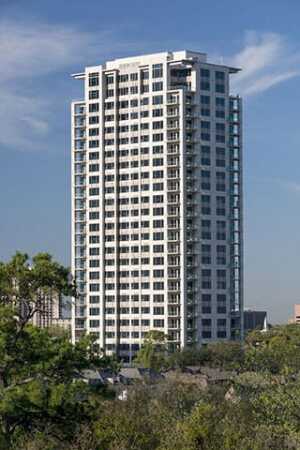
Houston’s residential market remains vibrant, says Giorgio Borlenghi, chairman of locally based diversified real estate corporation Interfin Companies. “We have completed our most recent luxury high-rise condominium, Belfiore, with 46 units starting at 4,600 square feet [427 sq m] and with an average price of $2.8 million,” he says. “It was our most successful project to date: all units but one were sold before the building opened.” (The Interfin Companies)
Like New Orleans, Houston continues to recover from the effects of a major hurricane. The emotional impact to Houstonians from last year’s Hurricane Harvey has been devastating for countless families, says Todd A. Rotholz, senior managing director in the Houston office of IRR.
“Although over 200,000 homes were damaged and close to 1 million people were displaced, at least temporarily, the impact to employment centers and jobs was relatively limited,” says Rotholz. “From a commercial standpoint, the supportive retail development in the hard-hit residential areas took the brunt of the impact. So, not only did the economy dodge a bullet, but now there are billions of dollars being injected into Houston for renovations, new homes, new cars, new furnishings, and so forth. Strictly looking at the economic factors and not the human trauma, this could actually have a positive impact on job growth over 2018, although a good portion of it would be temporary.”
Houston also managed to survive the recent oil bust without any annual job losses, Rotholz says, describing it as “an amazing feat that reflects the diversity of the Houston economy.” He adds that “2018 will bring job growth, but it will likely be modest, in the 40,000 range. If oil prices continue to improve over this year, 2019 could see Houston hit 75,000 to 100,000 in annual job growth.”
Global trade also is an economic driver in Houston. “The amount of foreign tonnage traveling through the Port of Houston is already the highest of any port in the U.S.,” says Rotholz. “With the recent expansion of the Panama Canal—doubling its capacity—the Port of Houston is spending more than $1 billion to keep up with demand and attract new business.”
Houston’s residential market remains vibrant, says Giorgio Borlenghi, chairman of locally based diversified real estate corporation Interfin Companies. “We have completed our most recent luxury high-rise condominium, Belfiore, with 46 units starting at 4,600 square feet [427 sq m] and with an average price of $2.8 million,” he says. “It was our most successful project to date: all units but one were sold before the building opened.”
Interfin is now shifting its focus to luxury multifamily rentals. “We see the fundamentals for this type of product quite strong in Houston,” says Borlenghi. “It is not only the young professionals who are drawn to this lifestyle, but older couples who want to downsize and simplify their lives and who are not interested in buying.”
North Texas continues on an economic upswing with strong development throughout the region. “DFW [Dallas/Fort Worth] has led the nation in job growth for the past decade, with over 100,000 new jobs each year in the past four years,” says Todd Savage, managing director in the Dallas office of financial firm HFF. “Population growth has also been robust. The trend of corporate relocations from the West Coast and the Midwest will likely continue due to our pro-business climate, central time zone, and educated workforce.”
The DFW economy is one of the most diverse markets in the country. “We continue to see strength in the financial, health care, and tech industries, with growth in every sector of the local economy,” says Savage. “The recent corporate campus developments for Toyota, JPMorgan Chase, and Liberty Mutual have been very exciting for the region. This has continued the need for more . . . housing and amenities.”
In addition, the Dallas area is becoming known internationally as a major medical center destination thanks to Baylor Medical Center being one of the top organ transplantation centers in the world, says Jimmy H. Jackson, IRR senior managing director for DFW. “The UT [University of Texas] Southwestern/Children’s Medical Center in the Stemmon’s [IH-35] corridor continues to draw young and old patients from across the entire United States,” says Jackson.
Dallas also has emerged recently as one of the top data center markets in the United States due to the steady stream of corporate headquarters relocating to DFW. “The continued and stable growth of high-tech companies allows data center owners and operators to tap into DFW’s abundant highly educated workforce,” Jackson adds.
Technology is also the primary economic driver in Austin, followed by government and the University of Texas. The city has plenty of jobs and a continuing demand for real estate development, adds Venditti. “It is difficult to get development planned and approved,” she says. “Usually, before a development is even completed, there is a shortage and that’s true in pretty much every major category of commercial real estate—as fast as it gets on the ground, more is needed.”
Austin and Texas are pro-business places with a minimum of regulation and low taxes, which attracts residents and companies to the region. “The ability of people to work without being in their physical headquarters has also affected the real estate market,” says Venditti. “I’m constantly running into people who live here but work for companies outside Texas. It’s a lifestyle choice that is driving population growth.”
Traffic and affordable housing are among the challenges that Austin residents face. “There has not been strategic long-term planning that has been able to be implemented,” Venditti says. “There have been plenty of plans, but the political will did not exist for them to be realized. The lack of affordable housing is also a concern. We need to address middle-income housing in Austin for nurses, firefighters, teachers, and others because the average single-family home price in Austin has gone beyond the national average.”
With strong economies and few signs of overbuilding, the South is expected to remain one of America’s most dynamic regions.







